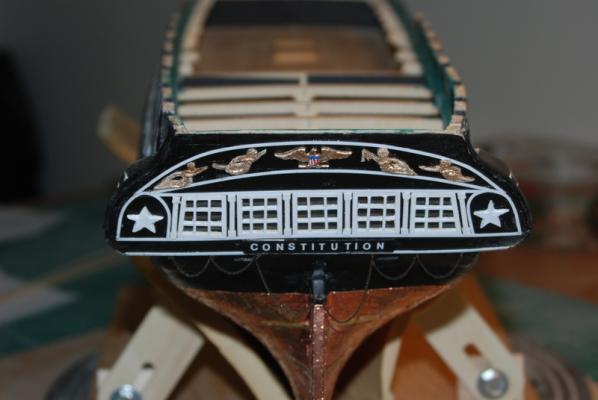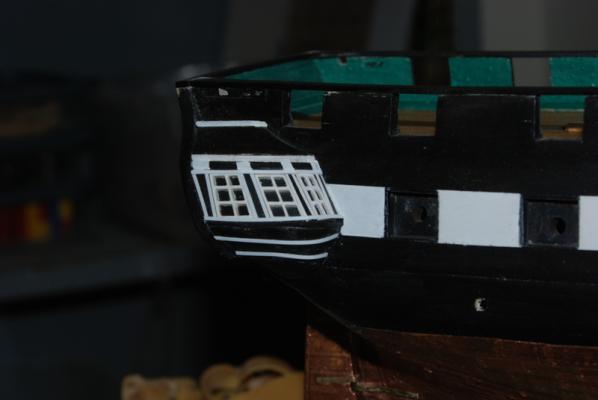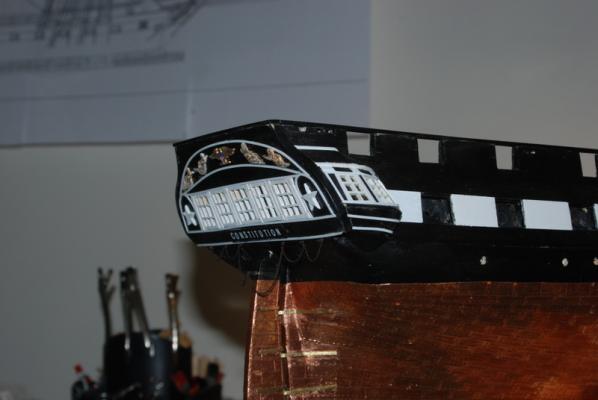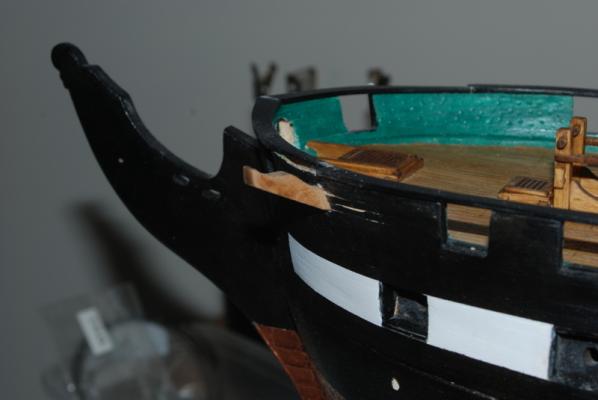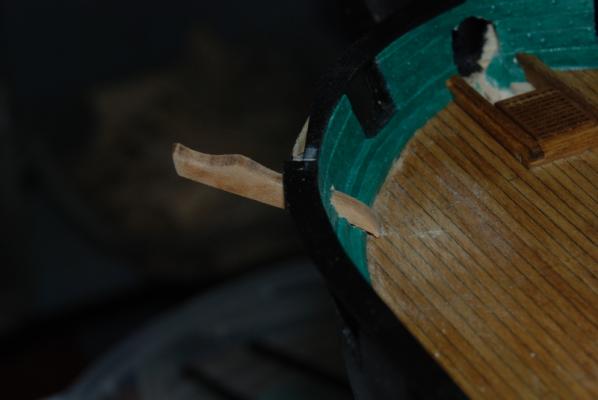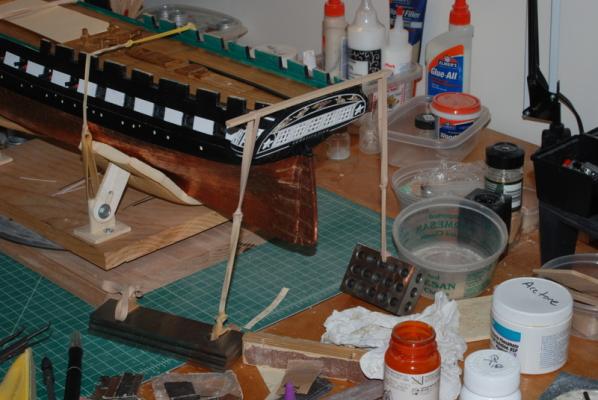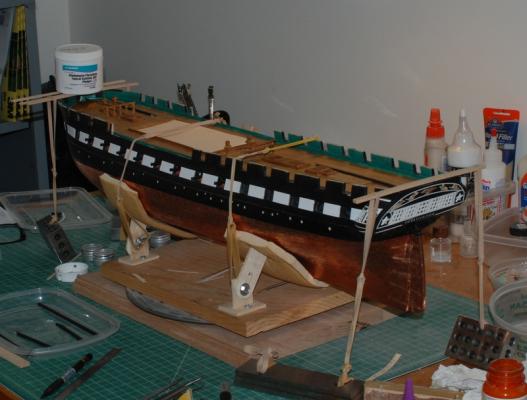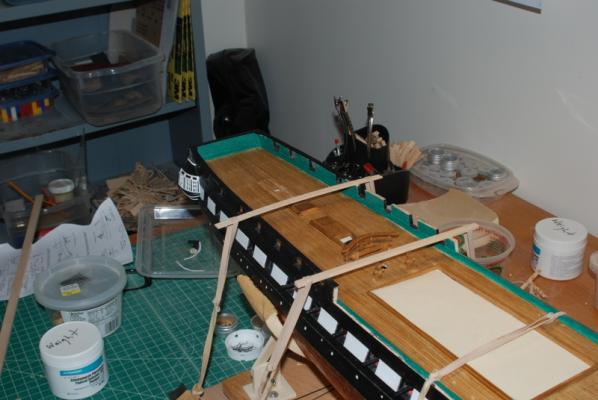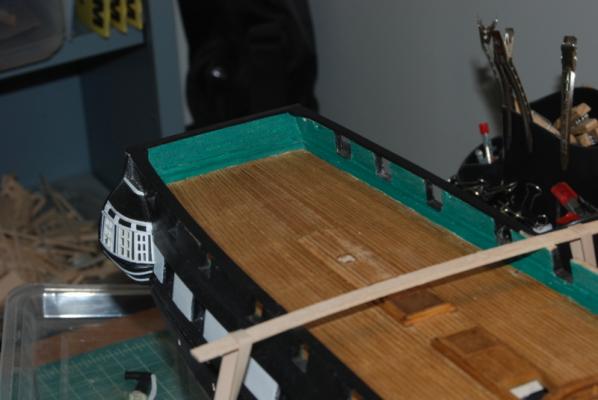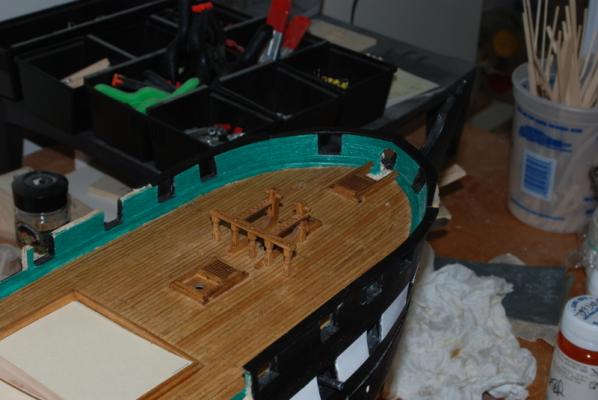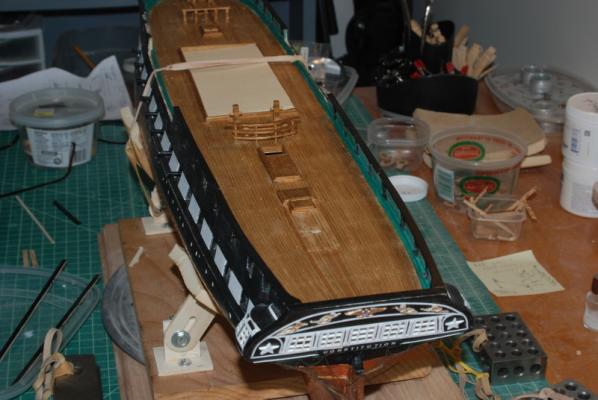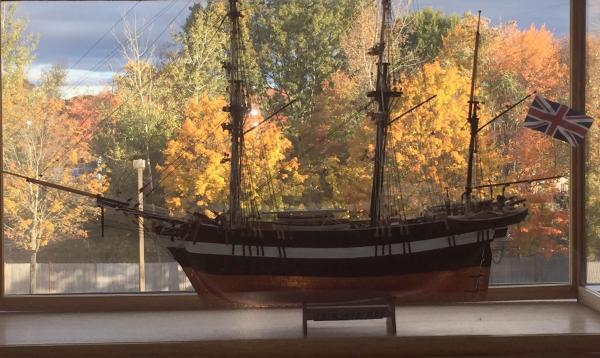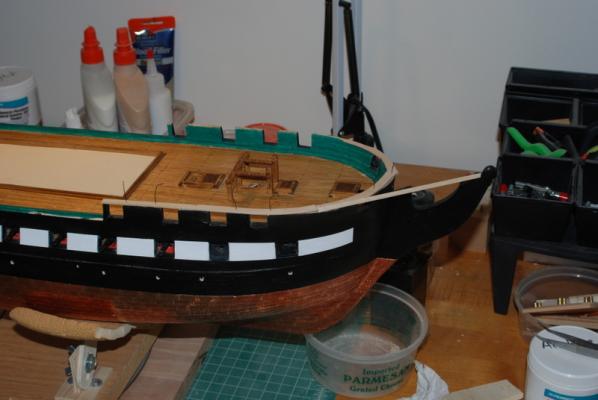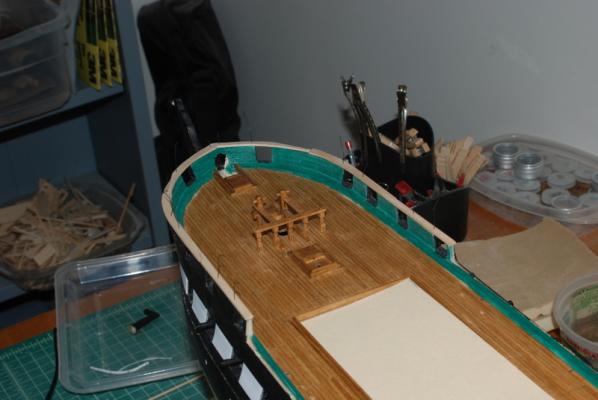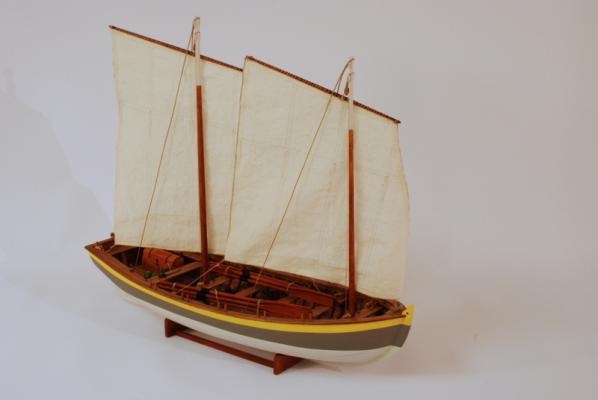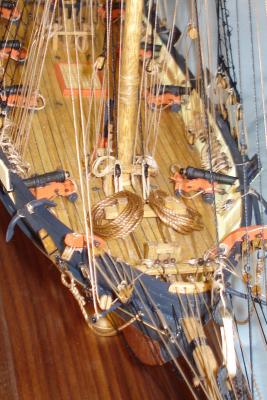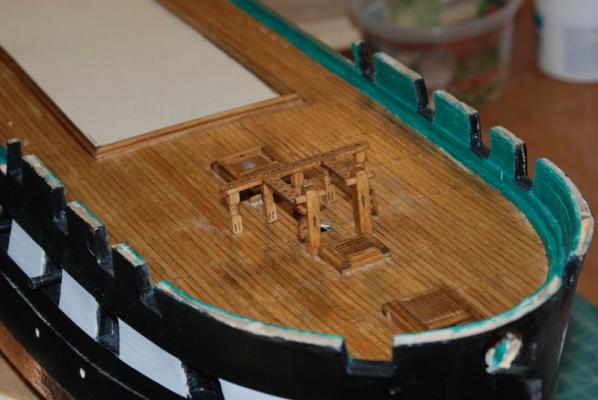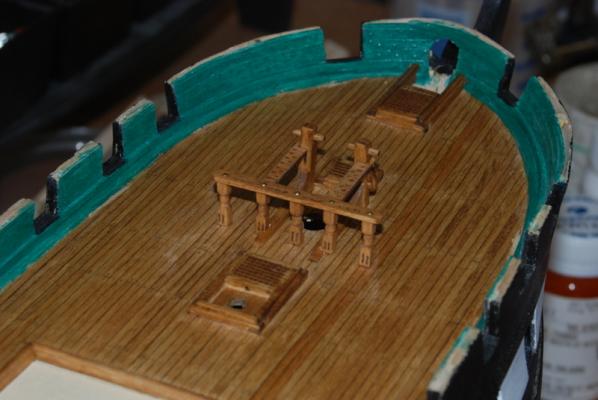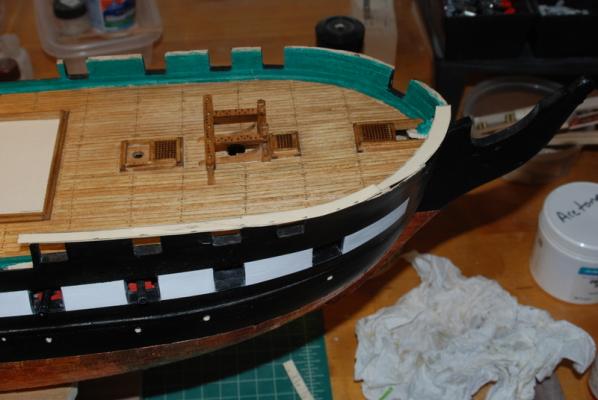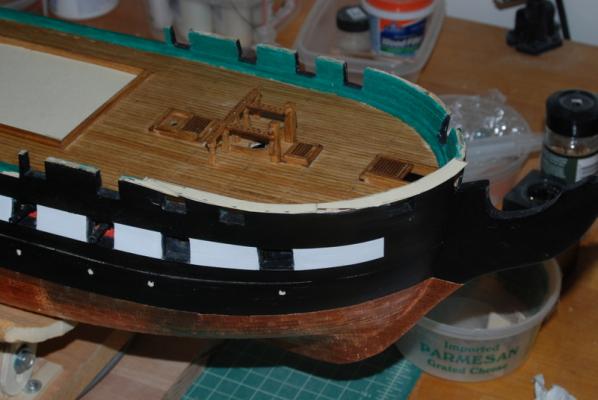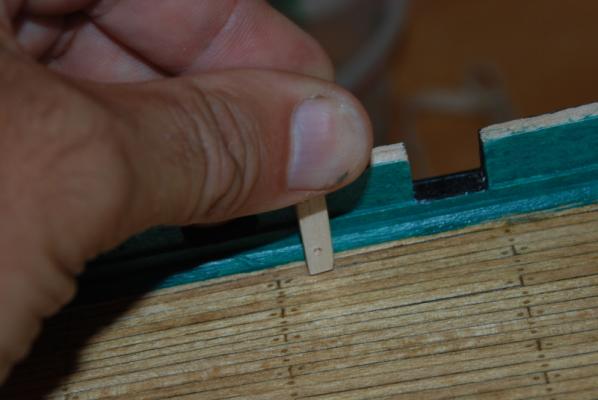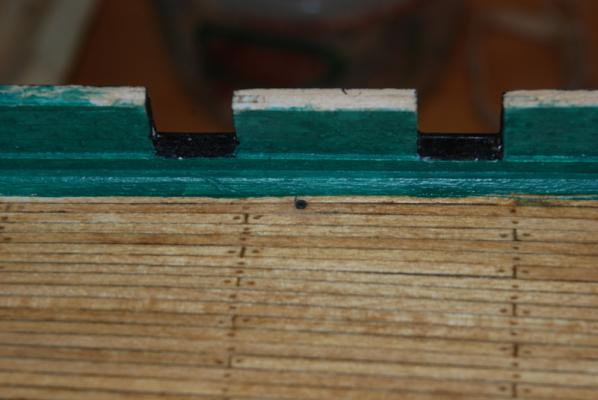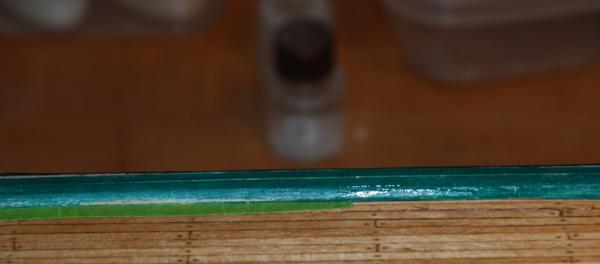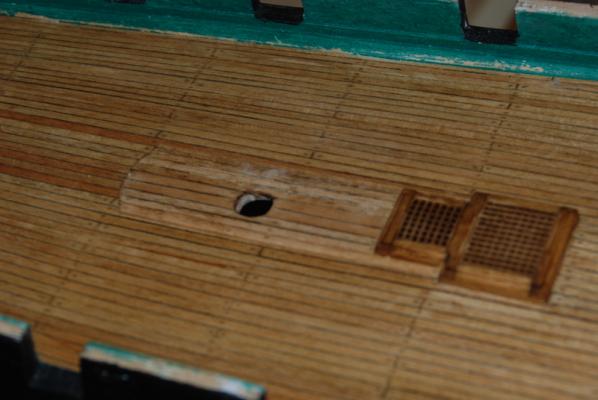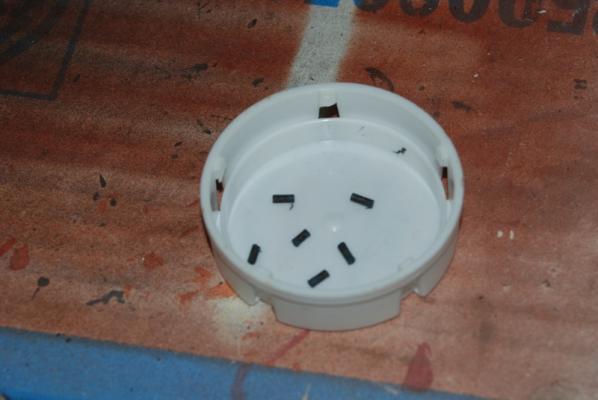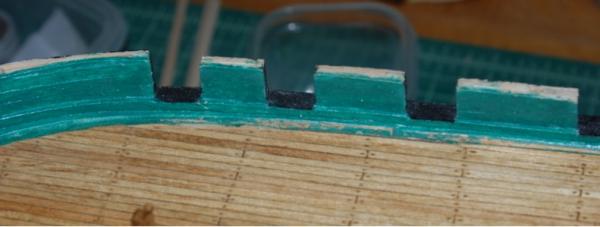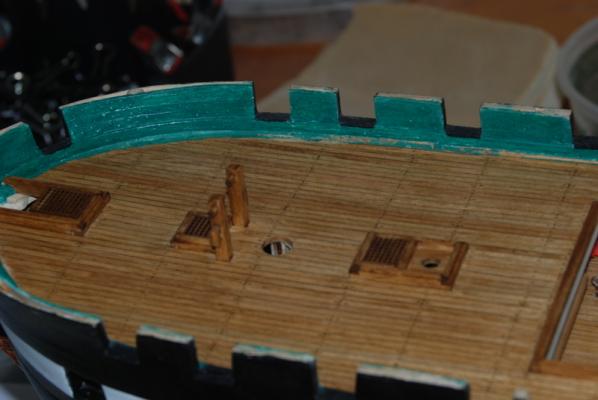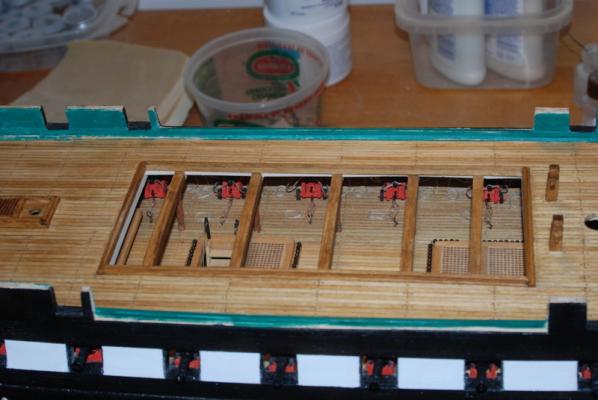-
Posts
2,407 -
Joined
-
Last visited
Content Type
Profiles
Forums
Gallery
Events
Everything posted by usedtosail
-
Don't worry, Jay. more pictures are coming. I just haven't had time to get them off the camera yet.
- 1,350 replies
-
- constitution
- model shipways
-
(and 1 more)
Tagged with:
-
Thanks Jay. Well, I did drill the hole on the other side for the starboard cathead, and let's just say it is a good thing this hull is painted. The catheads look symmetrical but there was a little hull patching to take care of, but once painted over it is all good. Again, I really admire you guys and gals that can work in unpainted wood with such good results. I drilled holes to simulate the sieves in the ends of the catheads and will be painting them black before installing. I also touched up the black paint on the rails, but no pictures today.
- 1,350 replies
-
- constitution
- model shipways
-
(and 1 more)
Tagged with:
-
"Can I see a close up of your transom and aft cabins" - Here you are Jay. This is how the transom looked when I finished adding the decorations months ago: And sadly here is how it looks today. I was really pleased with those details at the ends of the arms and now they are gone due to handling of the hull. I am going to try to recreate some of those details and reattach them, but I will be waiting until much closer to the end of this build so I don't mess them up again. I have not touched up the black paint under the rails yet, either, but will do that after the last rail piece is in place. I (somewhat) bravely drilled a series of holes through the port side bulwark for the cathead. This took a lot of syching myself up to do it and it was not easy due to the angle of the bulwarks and the angle of the hole needed. I started using a small drill that I drilled from the outside almost straight into the bulwark, then used larger drills at more and more of an angle. I finished the hole with square files to square it up until the cathead fit, and notched the bottom of the cathead to fit over the waterway and plank sheer. Now all I have to do is replicate this on the starboard side - same position, same angle, same depth. How hard can that be? I am not too optimistic that I can pull it off, but I will give it a go tonight. Wish me luck. Oh and I have to fix some planks around the port cathead hole that started to come up during the drilling process. I need to add some support behind them, which may be wood filler as the hole is too small to try to get a piece of wood in there. Oh and I also took a closer look at the scarf joints on the rails, and they could benefit from some wood filler, so I added that last night. And I have to clean up some scratches in the deck planks from the filing process. I should have put some masking tape down before I started drilling and filing, which I will do on the starboard side.
- 1,350 replies
-
- constitution
- model shipways
-
(and 1 more)
Tagged with:
-
I made up the stern rails this weekend, then gave them all a few coats of black paint. While they were drying, I thought about how to hold these down while I glued them. After some experimentation I came up with this approach, which is just rubber bands threaded through some metal blocks, that I can hook over the ends of some planks to hold the rail on down. These worked pretty well, but there were a few rails that I held with my fingers for a while until the glue set, to make sure they stayed in the right place. I started with the bow rails and the traffrail, then worked my way to the waist. One of the rails was a bit too short, so I ended up having to remake it, so it is being repainted now. Here is how the rest of the rails came out. I need to do some touch up of the paint around the rails, but the joints came out better than I expected, so no filler is needed yet. I know I will need to use some when I add the rails to the stem, which go in those areas that are still left rough near the bow. I bent a piece of wood for the fairleads at the bow and drilled a series of holes by hand with a pin vise. This piece is also getting a few coats of black paint so no pictures yet. Next up are the catheads.
- 1,350 replies
-
- constitution
- model shipways
-
(and 1 more)
Tagged with:
-
Good question Dave. I hope not. I have a feeling though that those folks interested in adding build logs are also interested in getting better at taking pictures of their hard work. I know I am. Were build logs really practical before digital photography? Like you said, the turn around times make for long gaps between building. Not to mention having to scan the paper pictures into the computer to post them, which takes a while. I walked into my office this morning to this scene: I keep my model of the Beagle on my window sill at work and the Fall foliage on the other side of the parking lot was lit by low sunlight. Of course, I only have my phone to take the picture, which did not help. There are a couple of problems with this picture. One was to get enough depth of field to have the model in focus and the trees in the background. The other was the dark office versus the bright outside. I did use a bit of fill light on the final image to bring out the model a little.
-
Thanks George and for those likes too. They are much appreciated. I traced the rail templates onto some 1/16" basswood sheet and strip wood and cut the pieces out oversize on the scroll saw. I sanded the edges down until they fit correctly with a slight overlap on each side of the bulwark. I didn't put a design into the edges but did round them slightly. The widths of the middle pieces were adjusted to be the same as the width of the bow piece plus the piece that goes to the stem on the front, and the back of that second piece was adjusted to the width of the straight strip wood used for the third piece, which will also be used for the rails behind the open waist. The scarf joints were cut in using an X-Acto knife and cleaned up with a small diamond file. I drilled small holes through the rail pieces into wood supports in the bulwarks, and put in some 28 gauge wire pieces, just to hold them in place while I fit them and their neighbors. I don't know if I will use the wire when I glue these in place after priming and painting them black. I may use the wire to position them then take it out if they look like they are attached well enough, which I suspect they will be. The joints are OK between pieces, but I know I will be adding a little wood filler and repainting the tops of the rails after they are installed, since these rails are painted. They are good practice for when I build something that I won't have paint to fall back on.
- 1,350 replies
-
- constitution
- model shipways
-
(and 1 more)
Tagged with:
-
What a great thread. Thanks for starting it Slog. I had a similar entrance into photography. I ended up getting a Master of Science Degree in Photographic Science, so I am a real technical geek but my artistic abilities are crap. That was many years ago however, and since then I got lazy and was using only a point and shoot for family pictures, until I started this hobby. I wanted to take better pictures of my models so I ended up back with a DLSR. I now have two Nikon D80 bodies, one of which stays in the workshop for progress pictures. I do tend to use the flash for these progress photos, though, but do set up better lighting for completed model pictures. I use a cheap macro lens too, for really tight shots, but will try cropping now that you have pointed it out. Its not like the old days where film grain was an issue, is it. Anyway here are a couple of shots of completed models
-
I then added the fore mast pin rail to the deck. I had made this piece a few months ago and used a piece of wood to hold it at the height of the planked deck, for alignment with the fore bitts. When I took that plank off the pin rail, I had a nice template to drill the three holes for the wire I had placed in the bottoms of the center and two outside supports. After test fitting the rail in the new holes, I removed it and place medium CA on the wire and bottoms of the supports and slipped it back into place. I then attached the two side rails to the bitts using CA glue. The whole assembly feels pretty solid now, so hopefully it will hold up during rigging. I then had to add the two pieces that sit on the deck (I am having a brain fart and can't remember what they are called). These had to be notched to fit around inside of the two middle supports. I used a square file to make the notches, then glued these to the deck and the bitts. Now I am getting ready to make the rails that sit on top of the bulwarks. I first test fit the supplied laser cut bow rails and taffrail. Neither of these fit well, so I will be making new ones to fit. I made up manila folder temples of the bow rail and fore rail sections, which took a while to get right. I made these slightly oversize so I can sand the rails to the final fit. The bow rail pieces have straight sections that the rails to the stem fit against, so I needed to make sure the angle was correct for them. I made the fore rail template long to fit all the way to the edge of the open waist, then figured out where I could use a straight piece of wood, and cut the temple into a scarf joint between two gun ports, so the joint would not be directly over a gun port. I flipped these templates upside down and test fit them on the port side, and it looks like they will work on that side too. Tonight I will use them to cut out the rail pieces.
- 1,350 replies
-
- constitution
- model shipways
-
(and 1 more)
Tagged with:
-
To continue with the scuppers, to install them I first opened up the drilled holes with a piece of the tubing I used for them: I then inserted a scupper piece half way into each hole using a hemostat: I then added a small amount of thin CA glue along the sides using a piece of wire: And pushed the scupper flush with the deck using a piece of wood And here is the result: Luckily, I made 9 of these pieces for the eight that I needed, because the first one I pushed in with an awl instead of a piece of wood and it went right through into the hull where it remains today since there is no access to that area of the hull.
- 1,350 replies
-
- constitution
- model shipways
-
(and 1 more)
Tagged with:
-
Hardly mastery Greg. But it is fun. Had a great long weekend in the Florida Keys last weekend, so not much work done on Connie this week. I did finish the doubler planks with oak stain and wipe on poly. I also touched up the green bulwark paint along the edge of the deck. I used short pieces of masking tape up against the waterway to keep (most of ) the paint off the deck planks. I cut short pieces of brass tubing to line the scuppers, which I blackened then painted the ends grey. I drilled the 8 scupper holes, but still have to glue the linings into the holes. Next up is to attach the fore mast pin rail which I made earlier, then start making and adding the rails on top of the bulwarks.
- 1,350 replies
-
- constitution
- model shipways
-
(and 1 more)
Tagged with:
-
I don't care what you say, Mobbsie, I am going to use your method as a tutorial. I have been using just a strip of black paper, but yours look sooo much better. Thanks for the method.
- 255 replies
-
- granado
- bomb ketch
-
(and 2 more)
Tagged with:
-
Thanks Greg. Those extra cannon carriages I used came from Model Expo. They sell a complete set for the gun deck. I think it is on the same page as the Constitution kit on their web site.
- 1,350 replies
-
- constitution
- model shipways
-
(and 1 more)
Tagged with:
-
Thank you Steve. That sounds like a great way to simulate the cannons on the gun deck. I can't wait to see how it turns out for you. Tim - No worries. It is Minwax Oak stain, straight out of the can.
- 1,350 replies
-
- constitution
- model shipways
-
(and 1 more)
Tagged with:
-
Thanks Tim, and those likes too. After a light sanding and clean up, I gave the spar deck planks two coats of wipe on poly. I used a fine piece of plastic "steel" wool between coats with a very light touch. I like this finish a lot, much better than the Tung oil I used on the gun deck. I used it on the coamings, bitts, and gratings too. You can see that there is some paint damage to the bulwarks from sanding the deck planks that I need to touch up. Before I do that though, I went through the plans and found a few more details to add to the deck first. I used 1/32" strips for the doubler planks around the mizzen mast, as shown on the plans. This was fortunate because I had elongated the mizzen mast hole slightly to get the mizzen mast to sit straight vertically side to side. Although the mast coat would have hidden that, I can now get the hole more rounded. These are the raw planks as glued on last night. They still some sanding and finish. I do have to be careful sanding them, however, because their thickness shows along the edges, not like the other deck planks. I am also going to be drilling holes for the scuppers in the deck planks, and fill them with some brass tube painted grey. Then I will clean up the bulwarks paint.
- 1,350 replies
-
- constitution
- model shipways
-
(and 1 more)
Tagged with:
-
Thanks for likes, guys. I finished drilling and filling the treenails, and gave the deck planks a good sanding with medium then fine sandpaper. I also scraped down a few high spots. I wiped the deck with a tack cloth and gave it a coat of pre-stain, wiped off the excess, and gave it a coat of Oak stain. I also gave the coamings and bitts another coat of stain. I was glad to see that the spar deck color matches the gun deck pretty well. I may give the spar deck planks another coat of stain though to even it out some more. I am going to use a different finish for the spar deck, though. I used Tung oil on the gun deck, but will use Wipe On Poly for the spar deck. The Tung oil was a bit blotchy and took a long time to harden up. When I checked my almost brand new can of Wipe On Poly, it was a solid mass . It looks like the plastic cap popped open at some point (or I forgot to close it the last time I used it? - nah! ) Instead of buying a new can, I decided to make my own by mixing 50% Poly with 50% mineral spirits. This way I can make up just as much as I need when I need it and store the Poly in a regular can. More to come on that later.
- 1,350 replies
-
- constitution
- model shipways
-
(and 1 more)
Tagged with:
-
Thanks for the clarification. This has been on my mind since I read this because I had to put a few into the sides of the Constitution deck planks but didn't want to put too many in.
- 1,051 replies
-
- cheerful
- Syren Ship Model Company
-
(and 1 more)
Tagged with:
About us
Modelshipworld - Advancing Ship Modeling through Research
SSL Secured
Your security is important for us so this Website is SSL-Secured
NRG Mailing Address
Nautical Research Guild
237 South Lincoln Street
Westmont IL, 60559-1917
Model Ship World ® and the MSW logo are Registered Trademarks, and belong to the Nautical Research Guild (United States Patent and Trademark Office: No. 6,929,264 & No. 6,929,274, registered Dec. 20, 2022)
Helpful Links
About the NRG
If you enjoy building ship models that are historically accurate as well as beautiful, then The Nautical Research Guild (NRG) is just right for you.
The Guild is a non-profit educational organization whose mission is to “Advance Ship Modeling Through Research”. We provide support to our members in their efforts to raise the quality of their model ships.
The Nautical Research Guild has published our world-renowned quarterly magazine, The Nautical Research Journal, since 1955. The pages of the Journal are full of articles by accomplished ship modelers who show you how they create those exquisite details on their models, and by maritime historians who show you the correct details to build. The Journal is available in both print and digital editions. Go to the NRG web site (www.thenrg.org) to download a complimentary digital copy of the Journal. The NRG also publishes plan sets, books and compilations of back issues of the Journal and the former Ships in Scale and Model Ship Builder magazines.




